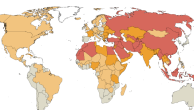In 2003, the Episcopal Church, USA, ordained a gay bishop, igniting an intense debate within the church over its views on homosexuality. Some local congregations that opposed the ordination voted to break away from the national denomination, leading to complicated legal disputes over the ownership of church property. There have been a number of similar disputes in recent years involving Presbyterian churches and other denominations. To explore these church property disputes and their constitutional implications, the Pew Forum turns to church-state scholar Robert W. Tuttle.
Featuring: Robert W. Tuttle, David R. and Sherry Kirschner Berz Research Professor of Law and Religion, George Washington University Law School
Interviewer: Jesse Merriam, Research Associate, Pew Forum on Religion & Public Life
In this Q&A: What prompted the legal disputes? The disputes in the courts Constitutional issues Looking ahead

What prompted these legal disputes over church property?
My guess is that there are about 100 congregations around the country involved in this type of litigation. Most of the lawsuits have involved more conservative congregations leaving national denominations due to a perception that the national denominations have become too liberal, particularly on issues involving homosexuality.
The breakaway congregations want to retain ownership of church property, but the national denominations claim that they own the property and that the breakaway congregations forfeit any right to the property when they leave.
The primary type of property at issue in these disputes is the congregation’s house of worship. For example, in a case taking place in Virginia, the fight is over the historic Falls Church, where George Washington was a church warden. But disputes also involve other sorts of property. One case, for example, involves a corporate jet that the local congregation bought.
How have the courts decided these cases?
The decisions have been all over the map, with some going in favor of the local congregation and some going in favor of the national denomination.
What has caused this inconsistency?
To understand why there is inconsistency, you have to go back to the English law on this issue, which permitted courts to decide whether a congregation was justified in leaving its denomination. In making that decision, English courts would determine whether the denomination had remained faithful to its own religious tradition. If the court found that the denomination had been unfaithful, then the congregation was free to leave and maintain control of its property.
The U.S. Supreme Court rejected this approach in a case called Watson v. Jones (1871), which involved a division within a Presbyterian congregation in Kentucky over slavery. In that case, the Supreme Court said that the English approach was an inappropriate way for American courts to settle intra-church disputes because such a method would entangle secular courts in judgments about religious doctrines. The high court said that instead of considering religious doctrines, U.S. courts should base their rulings on whether the congregation in question belonged to a denomination that was hierarchical in character. So if a congregation consents to join a hierarchical church body, then the court should defer to that hierarchy’s decisions, including decisions about control over the congregation’s property. But if a congregation is not part of a hierarchical body, then the congregation’s members – usually acting by majority vote – are free to control the property.
Selected Case Descriptions
There are about 100 pending lawsuits involving a national denomination and a local congregation fighting over who owns the church property used by the congregation. Below are descriptions of some illustrative cases from California, Colorado, New York and Virginia.
California In 2004, St. James Church in Newport Beach voted to break away from the Episcopal Church and Los Angeles Diocese due to disagreements over the national denomination’s ordination of a gay bishop. In 2005, an Orange County trial judge found that St. James was entitled to its property, worth several million dollars. The trial judge reached this conclusion by applying the “neutral principles” approach, a doctrine that permits courts to apply secular legal principles in deciding disputes within religious organizations. But in June 2007, a California appeals court reversed this ruling and held that the trial court used the wrong standard. Instead, the appellate court explained, the trial court should have applied the “deference to hierarchy” approach, which allows courts to settle intra-church disputes by deferring to church hierarchy. Applying this doctrine, the California appellate court held that the Episcopal diocese was entitled to the property. This case has been consolidated with similar ones, and in September 2007 the California Supreme Court accepted a request to review these consolidated cases. The California Supreme Court is expected to decide this issue by the end of 2008.
Colorado In May 2007, 93 percent of voting members of Grace and St. Stephen’s Church voted to leave the Episcopal Church and affiliate with the more conservative Convocation of Anglicans in North America (CANA). After CANA sued the Diocese of Colorado for ownership of the congregation’s property, which includes a $17 million historic landmark church in Colorado Springs, the Diocese filed a counterclaim, alleging that the Diocese is in fact the rightful owner of the property. The case is currently pending trial.
New York In March 2005, St. James Episcopal Church in Queens broke away from the Diocese of Long Island and affiliated with the more conservative Anglican Church in America. The breakaway members sued the diocese, claiming that they were entitled to the St. James property because the Church of England created the parish before the Episcopal Church existed. But in March 2008, a New York trial court held that St. James became an Episcopal parish after the American Revolution and the property, therefore, belonged to the Diocese of Long Island.
Virginia In December 2006, several congregations within the Diocese of Virginia decided to break away from the Episcopal Church. In April 2008, a trial court in Fairfax County ruled that an 1867 Virginia law governed the dispute. The 1867 law provides that when a “division” arises within a religious denomination, a congregation within that denomination may retain ownership of its property and join whichever part of the divided denomination it wishes. The court found that because the theological disputes within the Episcopal Church created a division within the denomination, the statute authorized the breakaway congregations to keep their church buildings and other properties. After the Episcopal Church contended that the statute violates the U.S. Constitution by entangling courts in religious affairs, the court conducted a hearing on this issue. The court ruled against the Episcopal Church on June 27, 2008, holding that the statute is constitutional and the local congregations are therefore entitled to keep their properties. The Episcopal Church is expected to appeal this decision.
How has this approach fared in the courts?
For the next 100 years or so, this idea of deference to church hierarchy was common among the states. But this changed in the 1960s when there was another big round of fights within churches. These disputes resulted from the growing perception that national bodies had become too liberal on issues such as civil rights and the Vietnam War. And this was exacerbated in a number of traditions in the early 1970s by the ordination of women to pastoral roles.
In deciding these cases, many courts were looking for alternatives to the rule adopted by the Supreme Court in Watson. The alternative arrived in Jones v. Wolf (1979), a case involving a Presbyterian church in Georgia, in which the high court approved a second way of resolving the disputes. Under the new approach, courts apply secular legal principles to hear and decide disputes within religious organizations. In applying this approach to church property disputes, courts examine the property documents to see whether the documents themselves identify who owns the property. The first approach – from Watson v. Jones – has come to be known as the “deference to hierarchy” approach, and the second approach is known as the “neutral principles of law” approach.
So now we have two alternatives, and states can choose between them. Since the Supreme Court’s ruling in Jones v. Wolf, most states have adopted the neutral principles approach.
How different are the two approaches?
The two approaches often overlap because national denominations know that to prevail under the neutral principles approach, they need to make sure that the congregation’s deed or governing documents expressly reflect the national denomination’s claim over the property. If these documents clearly provide for the national denomination’s control, then a court will likely rule for the national denomination, regardless of the approach it applies. But where the documents are not clear, the two approaches can make a world of difference, with the deference approach favoring the national denomination and the neutral principles approach not clearly favoring either side.
Are there any states that have not yet decided whether to adopt the traditional deference to hierarchy approach or the newer neutral principles approach?
Well, there are certainly states in which the highest court hasn’t reached that decision. The most important example right now is California. Most of the California intermediate appellate courts have said that the state follows the neutral principles approach. But in 2007, a California intermediate appellate court seemed to hold that the state followed a model of hierarchical deference. This case is currently before the California Supreme Court. So the California Supreme Court will resolve this split among its intermediate appellate courts by deciding which approach the state is going to follow.
There are some disputes about whether the statutes governing church-property disputes are constitutional. What are some of the constitutional issues that are involved in these cases?
One especially interesting constitutional dispute involves a number of Episcopal congregations in Virginia that have broken away from the national denomination. An unusual statute dating back to 1867 governs this dispute. The statute says that when a denomination is divided, a congregation within that denomination is free to vote on which part of the divided church it wants to join. Most significantly, the congregation gets to take its property, even if the denomination’s rules say otherwise. But it’s not clear that this way of resolving church property disputes is constitutional – it’s certainly different from the deference approach in Watson v. Jones and the neutral principles approach in Jones v. Wolf. The Virginia approach isn’t deferential to hierarchy; nor is it looking just at property and governance documents. Instead, the statute seems to say that if a court concludes that a denomination has divided, then rules of the denomination regarding control of congregational property no longer apply.
The constitutional question is whether this approach gets civil courts too entangled in religious matters. Those who are challenging the statute say that it requires courts to make a religious determination of what counts as a “division.” But those who defend the statute say that a civil court can decide when a denomination has become divided without getting into the substance of the religious controversy.
In early April 2008, a Virginia trial court ruled that the Episcopal Church was, in fact, divided as far as the statute is concerned. Therefore, under the statute, a majority vote of adult congregation members determines what will happen with the congregational property. Now the court is trying to decide whether the statute is constitutional. In other words, the court decided first that the statute applies to the controversy, and now it is conducting a separate round of briefings and oral arguments to determine whether the statute is constitutional.
[On June 27, 2008, the Virginia trial court ruled that the statute is constitutional and that the property belongs to the breakaway congregations.]
On the other hand, if the court decides that the statute is constitutional, the property would be awarded to the local congregations – at least in the short term – but, no doubt, the Episcopal Church would appeal. Either way, I think this case is ultimately destined for the Virginia Supreme Court because whichever party loses at this stage is going to want an appellate ruling on whether the statute is constitutional.
Is this the type of case that the U.S. Supreme Court would take?
It’s hard to say, but it’s possible that the high court would take such a case to impose some uniformity on the law.
Do you expect the number of these cases to increase or decrease in the future?
I think that we are seeing the bulk of Episcopal and Presbyterian church cases. Congregations that are interested in leaving those bodies are in the process of doing so now, and these cases will be heard and resolved within the next five years.
But there are other denominations that also have property disputes. For example, the Assemblies of God, the African Methodist Episcopal Church and even some parts of the Baptist tradition have relationships between the denomination and individual congregations that give the denominations a degree of control over the congregational property. Right now we are looking at disputes primarily over homosexuality or the liberal direction of national bodies, but it’s easy to imagine different types of intra-church disputes arising in the future.
Photo credit: Shawn Thew/epa/Corbis




